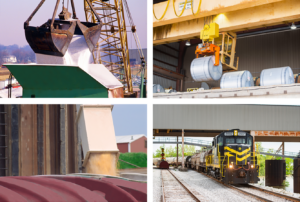Ports of Indiana ships second-highest annual total with 13M tons in 2024

Ports of Indiana shipped 13 million tons of cargo in 2024, the second-highest annual volume in the port authority’s 60-year history. Cargo shipments increased during the fourth straight year for the statewide port authority, up 3 percent from 2023 and second best to the 2018 record of 14.8 million tons.
“We have world-class companies operating at our three ports, and their increased use of our barge, ship, and rail services is a good indicator for Indiana’s economy,” said Ports of Indiana CEO Jody Peacock. “Agriculture products, coal, and steel-related shipments made up about 85 percent of our cargo in 2024, which demonstrates our ports’ critical role in the manufacturing, energy, and ag sectors. We’re pleased to see our ports have increased shipments by 50 percent since 2020, but our team is focused on investing in the future and making sure our facilities can support the growing needs of Indiana’s economy.”
Public and private investments into Indiana’s three ports totaled more than $200 million in 2024, including four company expansions, three new companies locating at the ports, and six federal grant projects supporting critical infrastructure investments. Ports of Indiana also launched Indiana River & Rail Terminals in 2024, which is the largest general cargo operation on the Ohio River. The new venture helped increase the terminals’ annual cargo shipments by 48 percent at Mount Vernon and 12 percent at Jeffersonville.
For overall shipments, the Mount Vernon port led the way with 6.6 million tons, 2 percent below 2023’s total but 32 percent above the previous four-year average. The Jeffersonville port handled 3.6 million tons, up 10 percent from 2023, and the Burns Harbor facility handled 2.8 million tons of barge, laker and ocean cargo, up 5 percent from the prior year.
The highest-volume commodities moving through Indiana’s ports were coal (3.7 million tons) and steel (2.9 million tons), followed by grain, soy products, fertilizer, minerals, ethanol, road salt, and DDGs (dried distillers grains). The largest overall increases came from steel (+246,000 tons), coal (+140,000 tons), and road salt (+80,000 tons), which was shipped at record levels during recent winter storms.
The largest percent increase was DDGs at Jeffersonville, which were up 1,773 percent due to the opening of the port’s new high-speed bulk terminal operated by Consolidated Grain & Barge. Other major increases included slag (+74%), salt (+44%) and steel (+14%) at Burns Harbor, salt (+17%), grain (+12%) and oils (+12%) at Jeffersonville, and salt (+48%), cement (+17%), and steel (+14%) at Mount Vernon.
According to a 2023 economic impact study conducted by the leading maritime economist, Martin Associates, Ports of Indiana’s business activities support more than 49,000 jobs and generate $8.7 billion annually for the state’s economy, including $3.5 billion in annual wages and $536 million in state and local taxes.
###
About Ports of Indiana: Ports of Indiana is a statewide port authority operating three ports on the Ohio River and Lake Michigan. Established in 1961, Ports of Indiana is a self-funded enterprise dedicated to growing Indiana’s economy by developing and maintaining a world-class port system, and by serving as a statewide resource for maritime issues, international trade, and multimodal logistics.
Information: www.portsofindiana.com
Media Contact: Eric Powell, (317) 233-6231 or e-mail

